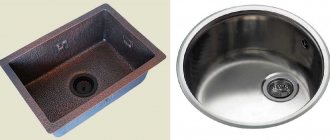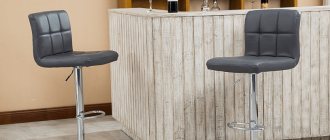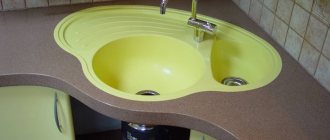Professional selection of kitchen sink
The kitchen is a room for daily use, where sanitary standards must be observed. Daily cooking is hard work, but the right equipment makes it easier and more enjoyable. A kitchen sink should be selected according to individual technical requirements, but do not forget about its appearance. When choosing a sink, attention is paid to the water supply device, the drainage system, the sink itself, its characteristics and dimensions.
Double
Models with double bowls have become especially popular lately. Structurally, they are similar to standard ones, but instead of one container they have two. Why is a double sink convenient for the kitchen? Its dimensions are larger, and the presence of two bowls greatly simplifies the process of washing dishes.
The maximum width in the structure can be 1200 mm, with a length of 800 mm. It is important for them to consider the possibility of installing a double siphon. Not all cabinets have the appropriate dimensions. It is also necessary to remember that most models are made only with a rectangular bowl shape.
What types of kitchen sinks are there: types of kitchen sinks
Sinks differ in the following parameters:
- configuration;
- dimensions;
- material;
- capacity;
- wear resistance;
- color and style.
At the same time, if the owners did not hire an interior designer during the renovation process, then it is better to wait when choosing a sink. In the final result, with a combination of colors and style, all the shortcomings will be visible.
Best kitchen sinks by size
The sink is installed leaving at least 50 mm around the perimeter or circumference. But the optimal depth of a household sink is 170-210 mm. However, a middle ground is found so that a convenient location allows you to wash baking sheets and large pots without difficulty. Sinks are available in several configurations with different parameters, some of the popular ones include the following:
- square with a side of 500 or 600 mm;
- rectangular – 400*600 mm, 500*(600, 800, 1000, 1250 mm);
- corner with sides 500*550 mm, 500*800 mm, or 500*1000 mm;
- round – diameter 450-510 mm, in rare cases 300 mm;
- oval – length 560-780 mm and width 44-510 mm;
- trapezoidal – 780*500 mm;
- with a sink depth of 160-210 mm.
Standard sizes
Today there are a number of standard sink sizes:
- for square-shaped equipment – 500*500 mm or 600*600 mm;
- for rectangular sinks – 480*850 mm, 500*770 mm, 440*780 mm or 510*580 mm;
- for round sinks – 450-510 mm.
The biggest
Large sinks are very practical and comfortable to use, meaning you can wash large dishes or clean a large number of plates in a short time. They are more reliable and durable, since they are resistant to sudden temperature changes and the effects of household chemicals, and are characterized by increased impact strength.
In addition, they are very easy to care for and do not change their original appearance for a long time. The most spacious large sink is considered to be a round-shaped product. If, first of all, preference is given to the functional purpose, then it is better to choose a large sink with several bowls.
Narrow
Narrow sinks take their place in small kitchens, where it is simply not possible to place large or standard sink models. Their width is no more than 300 mm. However, in terms of comfort they are not inferior to even the largest models. They are spacious, resistant to temperature changes, mechanical and chemical damage. In addition, they have an attractive appearance and can fit into any interior style and look harmonious regardless of the installation method.
Smallest - width
This parameter depends on the free area of the countertop. In small kitchens, round, square or trapezoidal sinks are most often installed; in rare cases, they are replaced with corner ones. If the housewife often needs to wash baking trays and large pots, then narrow sinks are installed in small kitchen spaces. Its only disadvantage is that due to its small width, it does not have space for drying dishes, so you need to allocate space on the countertop or make hanging shelves.
Appearance and shape
When choosing a kitchen sink, shape and appearance are the main factors. The shape of the selected sink depends on:
- kitchen dimensions;
- individual requirements;
- style concept.
Some sink models have a “wing” (a flat part that rests on the surface of the countertop). For a left-hander, the wing should be on the left side, for a right-hander - on the right.
Round sinks are considered the most convenient to use, however, while maintaining a clear interior style, they often choose awkward or bizarre shapes for kitchen sinks.
Material used
Practical Soviet sinks have been supplanted by numerous modern models, and no less durable. The choice of material when selecting a kitchen sink is determined by:
- individual wishes;
- style of the room;
- financial capabilities.
Today, copper, stainless steel, metal, stone or acrylic chips are used for production. Plastic derivatives are used less frequently.
With additional elements
The most common additional element of a kitchen sink is a drainer for drying dishes. It helps protect the countertop from moisture and allows water to drain from the dishes. Those who spend a lot of time in the kitchen often choose sinks with at least a small drain. They can be installed even in small kitchens.
If the wing is large, it is used for cutting vegetables, fruits, fish or meat. It is convenient to carry out cutting on such a surface because after work it is easy to wash it from grease or dirt. The additional element can be located on one or both sides. The number of wings and product parameters are determined by the working surface area.
How to best choose a kitchen sink: overview of characteristics
When choosing a kitchen sink, it is important to take into account its placement, configuration, and fittings.
The shape is determined by the area and installation method. Initially, you should decide whether the sink will be regular or with a projection. Then you should decide on its configuration and the specific location and method of installation. Overhead sinks are installed with clear dimensions of the cabinet or countertop.
If you need to install a large sink, but the configuration or dimensions of the kitchen do not allow it, then professionals recommend installing a standard round sink with great depth.
When installing the sink, you should pay special attention to the mixer; the water stream should fall into the center of the sink.
Depth and dimensions of stainless steel kitchen sinks
A deep sink should be installed if the housewife constantly uses baking sheets and large pans, and if there is no such need, then a sink with a depth of 160-200 mm will do. Otherwise, you will have to constantly bend over, which will lead to discomfort in the lumbar region.
However, if you lift the sink, this problem will be solved. But sinks with a depth of less than 160 mm are not recommended for installation in the kitchen, because water will constantly splash out. In narrow models of sinks this is taken into account, so they have a depth of 200 mm or more.
Number of containers
There are classic sinks with one bowl and multifunctional sinks with two or more.
In the latter case, you can simultaneously wash and rinse dishes and defrost food. However, the width of these sinks is from 800 mm. In multifunctional sinks, the sink can be divided into equal and unequal bowls, which can have different shapes and depths. The compartment intended for defrosting has the smallest depth and area.
When choosing a multi-section sink, it is recommended to focus on the option where the main compartment has a width of at least 420 mm. Multifunctional sinks are very convenient for stationary catering outlets; to install them, the minimum countertop width must be 800 mm.
Drying area
Some sinks already have a “beach” or “wing” in their design - this is a place for drying dishes and storing dishwashing detergents. However, some designs do not provide for this, and this point should be taken into account when choosing the type of sink. That is, you need to either allocate a place near the sink in advance for drying dishes, or, if the countertop area does not allow, make hanging shelves.
Draining
There are several types of siphon, differing in the following points:
- design;
- diameter;
- type of pipe.
Typically the pipe diameter is 320-400 mm. By design, there are flask, corrugated and pipe drains. The flask design is most often used, because if clogged, the system can be easily cleaned independently. The corrugated structure is one-piece, so to clean the drain system you will have to completely disassemble the structure. The pipe design is used mainly in catering units, where the sink is actively used; two sinks can be connected to such a system at once, using adapter and rotary flanges.
Additional safety and practicality devices
The installed sink can be equipped with various systems. For example, an electric disposer that crushes food residues that, along with water, end up in the drain. Also, if there is no space for drying dishes, you can use additional trays.
Cabinet or cabinet dimensions
To install a sink in the kitchen, you will need a floor cabinet or cabinet where all the wires, pipes, siphons, filters, food waste grinders are placed, and also supplemented with shelves or storage containers.
The cabinet or sink cabinet is made in the same design and has the same height as other furniture. They are often made more durable, since a sink made of stone or ceramics has significant weight.
The most important indicator when choosing a cabinet or cabinet is the distance between its side walls. On top between them there is a bowl or several bowls. Below, inside the cabinet, there are all sewer and water supply equipment.
- For an overhead model, the distance between the side walls of the cabinet should match the width of the sink itself.
- For mortise ones, this size is usually indicated in the installation diagram. There are several standard cabinet widths - 45, 60, 70 and 90 cm.
The standard depth of a kitchen cabinet, like other kitchen furniture, is about 60 cm. Most models are produced taking these values into account.
The standard height of kitchen furniture is 82-85 cm, but people who are taller or shorter than average are often forced to order sink cabinets made to measure.
Which sinks are the most practical for use in the kitchen?
The most practical round sinks are with a diameter of 600 mm, but if the dimensions of the kitchen do not allow the installation of such equipment, and the family is large, then a sink with a diameter of 450 mm and a depth of 200 mm is suitable.
If you have a dishwasher, you can install a narrow sink no more than 300 mm in diameter. If the sink will be placed in a corner, and the dimensions of the kitchen allow you to install a large sink, then it is better to install multi-section trapezoidal equipment with a pull-out mixer.
For sinks with a depth of up to 160 mm, you should choose a tall L-shaped mixer, and for greater depths, with a higher spout.
DIY installation
If you purchased a stainless steel or faux granite sink, you can install it yourself.
To do this you will need:
- jigsaw;
- ruler;
- pencil;
- screwdriver.
- First, remove the tabletop and place it with the inside facing up.
- We attach to it a sink or cardboard of the appropriate size, which usually comes with the sink. We outline it with a pencil.
- We make an allowance of 1.5-2 cm in the direction of reducing the hole, so that there is something to support the sink.
- Cut a hole using a jigsaw. It is better to drill holes on the rounded edges and then connect them with a cut. This will make the work easier and the cut will be much smoother.
- We sweep the cut from sawdust and treat it with silicone sealant. We also apply this composition to the edge of the sink.
- We glue the sink well to the countertop and secure it from the wrong side with special fasteners.
- We install the countertop on the kitchen unit.
- We connect the siphon and mixer.
What material is best to choose a kitchen sink from and how to do it correctly?
Today there is a variety of materials used in the production of sinks. The choice depends on the available space in the kitchen, budget and personal preferences.
The best sinks are natural stone
Sinks made from this material will fit perfectly into absolutely any interior style. This is explained by the following advantages of the material:
- environmental friendliness;
- resistance to temperature changes;
- reliability;
- practicality;
- does not require additional care.
Another big plus is that stone is a noise-absorbing material.
Marble chips: which sink is better - stone or stainless steel?
These sinks are made from synthetic binders and marble chips of various fractions. The quality of such products depends on the percentage of binders and crumbs; the more marble, the longer the sink will last. Typically the ratio is 80% crumbs and 20% binder, however, there are models where marble is 94-95%. Such sinks absorb noise well, have a wide choice of colors, and are resistant to chemical and thermal influences.
However, there are also disadvantages:
- high price;
- heavy weight;
- It scratches easily, so do not wash it with steel wool or other scrapers.
It is difficult to talk about which one is better, since these sinks have different technical characteristics, prices and characteristics. Stainless steel will suit any interior, while stone ones require an ideal stylistic balance of natural materials.
Acrylic
Acrylic sinks are resistant to all stains and do not react to acids and alkalis.
Moreover, stainless steel sinks are inferior to them in the price range. Acrylic is a brittle material that will scratch when exposed to abrasives. However, with constant care, acrylic sinks will last a long time.
Glass
Glass sinks are made from tempered glass, which has increased strength and high resistance to impact and abrasion. They also do not react with strong acids and alkalis; the use of abrasives is not required to clean such products. And the only negative is the high cost. In built-in sinks, an additional rubber layer should be installed.
How to choose the right stainless steel
Stainless steel sinks come with a smooth surface and ribbed, as well as seamless and welded. In the second case, metal of greater thickness is used. In one case or another, they strongly transmit the noise of flowing water, so it is recommended to install rubber gaskets under them.
This is the most budget option, although it has high wear resistance and resistance to thermal changes, and reacts with acids and alkalis. With minor impacts, a dent may form, and with a strong impact, a breakdown may occur. This is an anti-corrosion material that transmits water noise well, so the back of the sink is covered with a special noise-absorbing layer.
Metal or steel are the best sinks
Many companies produce steel sinks with standard sizes, most often they are round or rectangular. Steel sinks have replaced cast iron ones, because cast iron is susceptible to corrosion.
Hole dimensions
Installation dimensions or installation opening refers to the size of the hole in the countertop into which the mortise sink is to be installed. The installation dimensions are larger than the dimensions of the bowl, but smaller than the dimensions of the sink itself. They are indicated in the installation instructions.
Some models, such as the Blanco Tipo 8 Compact, come with a template for insertion. They can be installed in the cutout from above or below. In the first case, a hole is cut for the entire sink, including the wing, if any. In the second, a hole is cut in the shape of a bowl or several bowls.
For this model, the hole size is 76.2x48.2 cm.
As a rule, countertops and sinks with bottom placement are made of artificial or natural stone, since the open side of the countertop is constantly exposed to water.
Manufacturers of household appliances offer customers a huge number of models in all price categories. Famous Italian and German brands Blanco, Franke, Fulgor Milano, Kuppersbusch, Restart, Smeg are widely represented in the Hausdorf store. With us you can choose a sink of any type and size from any materials. All products come with a warranty, and we deliver and install most models free of charge.
Manufacturers
The following companies are included in the ranking of the best kitchen sink manufacturers:
- Blanco - for durability;
- Alveus – for the variety of models;
- Franke – for resistance to temperature changes;
- GranFest – for the color scheme;
- Omoikiri – for capacity;
- ZorG - for strength and sound insulation;
- Melana – for the price of the assortment;
- TeKa – for quality.
In any kitchen you can choose a sink that will be convenient and fit perfectly into the interior. If necessary, you can supplement the sink with accessories.











